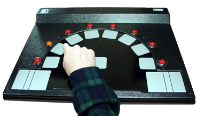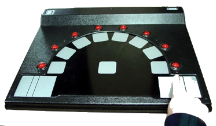FACT SHEET - MODEL BEP I
Central Processing and Upper Extremity Motor Control Performance
MEASURES |
FEATURES |
||||
|---|---|---|---|---|---|
  |
|
|
|||
The Model BEP I is a multi-function instrument designed to acquire many different standardized upper extremity motor control and basic central processing performance measures. It is our most popular instrument.
This unit measures more than 40 performance variables, including basic elements (response speed, visual-spatial memory capacity, etc.) and higher level task performance (ADL's, finger tapping speed, coordination, etc.). These performance resources are those most often affected by head injury, progressive neurologic disorders or diseases, aging, etc. and are also those which are relevant in simple tasks of daily life as well as demanding sport and work tasks. With this versatility, the BEP I is our most popular BEP module.
A BEP I system consists of: 1) HPM's proprietary "BEP for Windows™" software* that runs on a user-supplied “host computer” and allows the user to focus on the test subject, not the ancillary tasks of measurement (part of BEP-SAK**); 2) a rugged interface unit (the BEP I module) that interfaces to the host computer through a simple serial port connection and provides visual stimuli and senses subject responses made with the upper extremities during one of the multiple standard test protocols; 3) a compact power supply (part of BEP-SAK**); and 4) a step by step manual for easy set-up and use (part of BEP-SAK**). The BEP I module is positioned on a table in front of the subject who uses it to execute basic tasks designed to stress specific performance resources. It has two interface regions. One has eight high-speed stimulus LEDs and corresponding high speed touch sensor pairs arranged in a semi-circle around a central “home” touch sensor. The second region has six additional touch sensors ("left" group of three and "right" group of three) which are used in coordination and other standardized rapid alternating movement speed tests. Tests consist of short, well-defined tasks (10-30 sec) that permit rapid documentation of performance capacities that have been established as important characteristics of the involved subsystems.
Coordination is addressed with a unique approach based on Fitts' Law and confirmed with performance theory. Short duration (10 sec) test tasks are employed during which an isolated system (e.g., upper extremity) is maximally stressed along speed and accuracy dimensions. It produces a measure of neuromotor channel capacity in bits/sec, which has been investigated and validated for more than two decades.
Optional BEP I accessory packages are available to provide additional measurement scope. The BEP I-MD Manual Dexterity Package includes large and small pegboards for gross and fine manual dexterity performance measurement. BEP I-ADL Activities of Daily Living option consists of a set of durable items required for standardized measurement of higher level ADL tasks (putting on a shirt, buttoning buttons, etc.)
Results acquired with this and other BEP modules are extracted from data acquired during test trials, stored in a local database, and presented in raw form with scientifically accepted units (e.g., centimeters, Newtons, seconds, bits, etc.) as well as in a compact graphical Z-score format. Z-scores represent a single number means to place a given test result in the context of a reference population (i.e., number of s.d. units from reference population mean). Age and gender adjusted Z-scores are automatically computed using databases derived from populations of healthy individuals. Reports are accessible immediately from the video display or in printed form. To assist researchers, “BEP for Windows™” can export group data in text file format for statistical processing.
This BEP module is one in a family of HPM's tools designed to provide professionals with a standardized basis for arriving at routine client assessments and for conducting high quality research. Our approach is to augment accepted subjective evaluations and ad hoc "collections" of test equipment with an integrated set of professional tools for objective measurement of structural, performance, and behavior parameters. Our goal is to save time, and therefore expense, while improving measurement quality and scope.
----------------------------------------------------------------------------------------------------------------------------------------------------------------------------------------------
*Computer Requirements: IPC™ with an available USB or serial port. Tested with Windows™ 95 and later. Inquire about use with Macintosh computers.
**BEP-SAK is the BEP Start-up Accessories Kit. It must be separately purchased. Only one is required for a single module or multiple module set-up. A 50% discount is provided with the purchase of the first module.
▾
▾